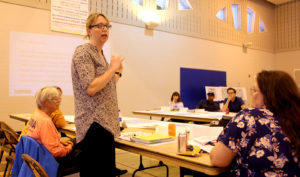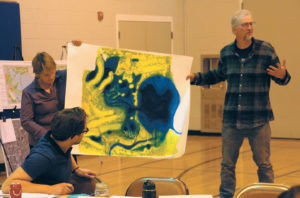
What can the Hiawatha Golf Course Community Advisory Committee (CAC) agree on?
Towards the end of the sixth CAC meeting on June 11, 2019, members began working on a list of recommendations for the Minneapolis Parks and Recreation Board (MPRB) on what they’d like included in the Hiawatha Golf Course Master Plan. Three concepts with various amenities such as environmental play areas, fishing pier, BMX/pump track, disc golf, water access, amphitheater, aqua range, larger parking lot, bird blinds, outdoor firepits, and more had been presented in March 2019.
However, CAC members can’t agree on what form golf should take in the future as some members continue to push for an 18-hole golf course.
CAC members began working on their list following over an hour of community comment and about an hour of comment from themselves. Any of the 100 or so people gathered who wanted to speak were given a chance to, and the meeting went late. Over 200 people also submitted comments at open houses held earlier this year, and many others shared input via an online survey.
“The consensus seems to be less is more,” said CAC member Anne Painter after hearing public comments. “Simplify things. Nokomis is right next door.”
MAKE TRASH A PRIORITY
CAC members want to balance natural and recreation spaces with appropriate plantings, while keeping costs low for both capital improvements and maintenance.
The majority of CAC members agree that pollution mitigation with the involvement of the city is a top priority.
“Trash and pollution mitigation have to be incorporated into what we’re doing,” stated CAC member Nathan Shepherd.
A revised or improved clubhouse with winter activity is recognized as a nice amenity to have at Hiawatha Golf Course, and some from the audience voiced support for a dog patio. Others were concerned this would gentrify the neighborhood.
All seemed to agree on a more purposeful interpretation of African American and Indigenous history, art, and culture at the site, whether that is through public art or menu items at the clubhouse.
 CAC members Roxanne Stuhr (left) and Sean Connaughty share their idea for the future of Hiawatha Golf Course, one that focuses on water being in the low areas. (Photo by Tesha M. Christensen)
CAC members Roxanne Stuhr (left) and Sean Connaughty share their idea for the future of Hiawatha Golf Course, one that focuses on water being in the low areas. (Photo by Tesha M. Christensen)SHOULD A TRAIL FOLLOW THE LAKE?
Most CAC members would also like to see the fence come down strategically in order to increase accessibility to park and water.
There was a lot of discussion around having a safe walking path around Lake Hiawatha, and whether it should be directly adjacent to lake or not. Over the past few years many citizens have stated they’d like to be able to walk around the whole of Lake Hiawatha as they do Lake Nokomis. CAC member Sean Connaughty, who has removed over 6,000 pounds of trash from the lake over the past few years and serves on the Friends of Lake Hiawatha, is concerned that if a trail is installed next to the lake in the areas that are currently undeveloped that the diversity of wildlife around Lake Hiawatha will disappear. “We won’t have otters living around the lake,” he observed.
Neighborhood resident Ryan Seibold agreed and urged CAC members to “keep this area the sanctuary that it is.”
OPINIONS MIXED ABOUT GOLF
CAC member Kathryn Kelly submitted a petition with the signatures of over 400 people who support keeping an 18-hole golf course. In its 2017 directive to the CAC, park board members directed them to create an option with at least 9 holes of golf.
Craig Nichols, who is a CAC member and golfer, pointed out that many of the items in the three concepts created for the site are available at other parks. “It seems a little bit to me that we’re taking one community and saying we want another community to use it instead,” he stated.
He pointed out that incorporating some pieces of the concepts developed by the design team, such as putting bee hives and wildflowers on the property, could be done if it remained an 18-hole golf course.
Twenty-year South Minneapolis resident Dave Frolick observed that there are options for biking and activities at nearby parks, but there is no other place to golf but Hiawatha. He observed that his 18-year-old son, Jay, has been part of the First Tee program at Hiawatha Golf, and just recently had the opportunity to play at Pebble Beach.
“This area wants to be a wetland,” observed Connaughty. He held up a concept for the property that he and a few others had worked on and showed it to the group gathered. “Can we use the dry spaces and existing topography and layout to create 9-holes?” Connaughty asked. “I think we can design this to be self-sustaining in a way that doesn’t need to be constantly managed and manipulated.”
Landscape designer and CAC member Roxanne Stuhr remarked that the golf course shouldn’t be the only place for water to go. “Our neighborhood is a sponge,” she said. “Each of us has a house where we can absorb water.” If it isn’t absorbed there, it goes into city streets and down into waterways, where it causes flooding.
Community member Bobby Warfield pointed out that 14 billion gallons of water flow into Lake Hiawatha, and the park board is concerned about 292 million gallons that have been deemed excessive pumping at the golf course. He blamed the Minnehaha Creek Watershed District and those upstream for not doing their job and causing problems downstream.
“It costs $15,000 to pump. We’re going to spend $60 million to make it into a monument to ourselves? That doesn’t solve anything,” Warfield said to applause from attendees.
“Our neighborhood is home to an expanding number of families who desire more opportunities than just golf,” stated Matt Hilgart.
WILL MPRB SELL GOLF COURSE?
Some members of the public expressed concern during the meeting about MPRB selling the golf course property to private developers who might build homes on the land. According to Pederson, while MPRB can sell park land it is incredibly difficult.
“To sell property, we’d need to define the property as no longer needed for park purposes, then seek property disposal approval through the district court. During that district court hearing any party can step forward and dispute our disposal intentions as being unnecessary,” Pederson said.
TOUGH TO HEAR
Throughout the meeting at Pearl Park, attendees expressed frustration that they couldn’t hear what the CAC members were saying. They requested that CAC members stand up and face them, which most did after being asked. Some stepped off to the side to make it easier for audience members as well as fellow CAC members to hear.
Following the meeting, Pederson said that he intends to bring a microphone to remaining meetings when CAC members are speaking to the public or the public to the CAC members.
The conversation about what should be included in the master plan will be continued at a later meeting; a date has not yet been set. The CAC may have preferred concept by August 2019. If that happens, a public hearing is likely for October following a 45-day comment period.
Curious about water issues?
Curious about how Lake Hiawatha works within the larger Minnehaha Creek watershed?
Go here for answers:
>> Minnehaha Creek Watershed District studies: https://minnehahacreek.org/project
>> 2017 Water Management Alternative Assessment for Hiawatha Golf Course: https://www.minneapolisparks.org/_asset/hs0vsd/July-2017-Executive-Summary-Hiawatha-Golf-Course-Assessment-Report.pdf
>> Hiawatha Golf Course Assessment Area Pumping of Groundwater & Stormwater Project page: https://www.minneapolisparks.org/park_care__improvements/park_projects/current_projects/hiawatha_golf_course_improvements/
>> Nokomis-Hiawatha Regional Park Master Plan, https://www.minneapolisparks.org/_asset/1dg1fv/nok_hia_masterplan.pdf
Comments
No comments on this item Please log in to comment by clicking here